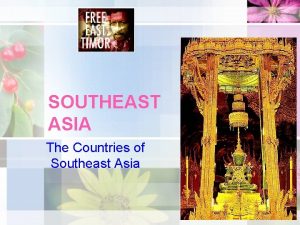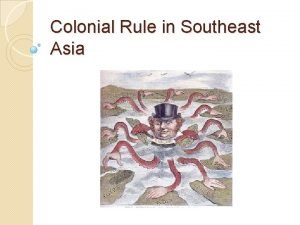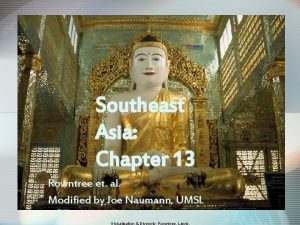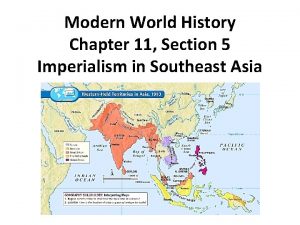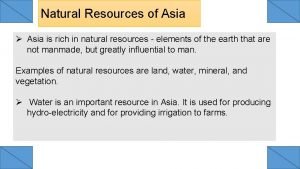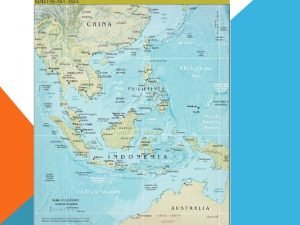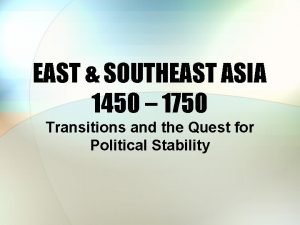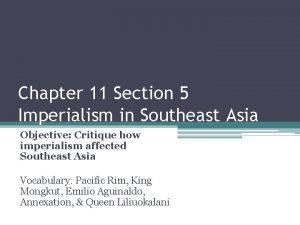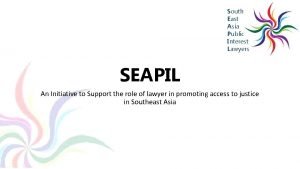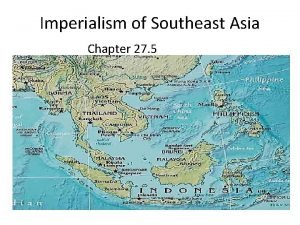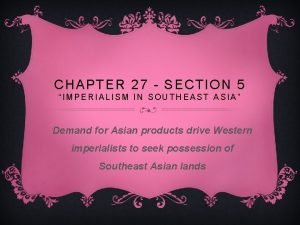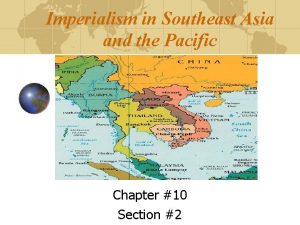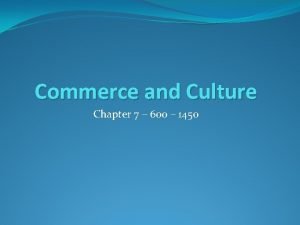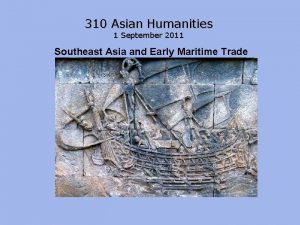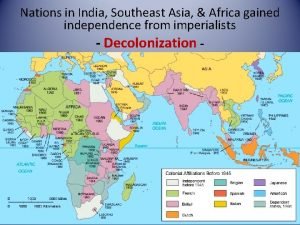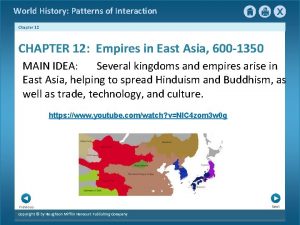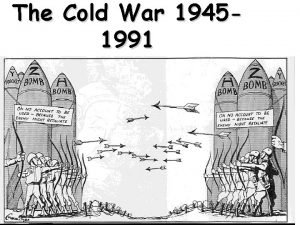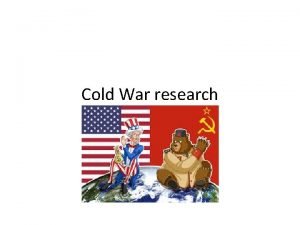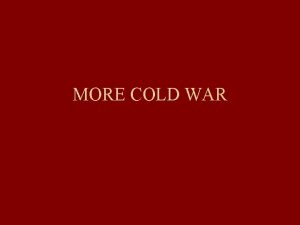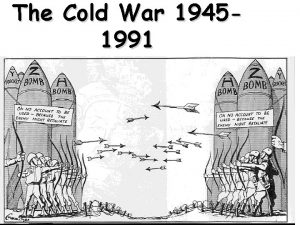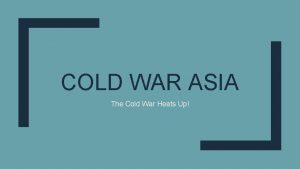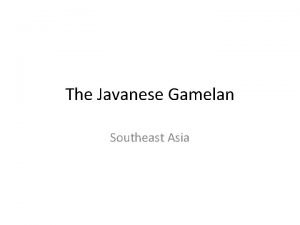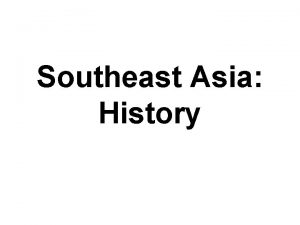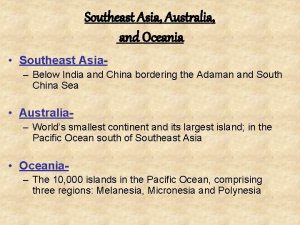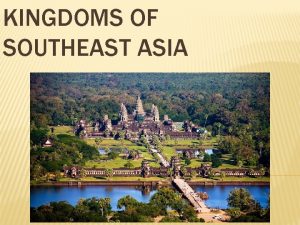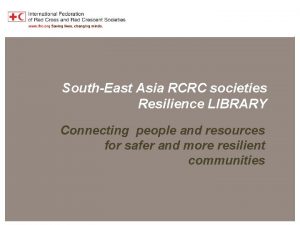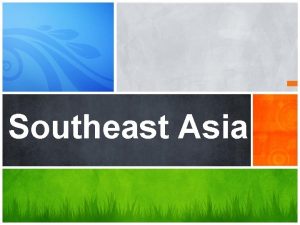Southeast Asia Cold War in Southeast Asia U





















- Slides: 21

Southeast Asia

Cold War in Southeast Asia • U. S. supported independence of colonial people. • U. S. feared the spread of communism • Southeast Asian countries lack experience in selfgovernment

Let’s take a closer look at the War! http: //www. youtube. c om/watch? v=r 0 t. YBemwzs

• First Battle Vietnam Two Battles • 1946 -1954 Ho Chi Minh, Vietnamese communist, resist the Japanese invasion. • Controlled Northern Vietnam • French tried to maintain control of Indochina (peninsula of SEAsia) • With peasant support and guerrilla fighters he forced the French out.

Ho Chi Minh Viet Cong

A Divided Vietnam • • • Struggle in Cold War 1954 conference in Geneva, Switzerland, western and communist powers agreed to a temporary division of Vietnam North Vietnam= Communist South Vietnam= noncommunist, led by Ngo Dinh Diem Cambodia and Laos became independent



South Vietnam Ngo Dinh Diem

Reunite Vietnam • 1956 agreement called for elections to reunite Vietnam. • Domino Theory: U. S. was afraid that if election were held that south Vietnam would fall to communism that would sweep across Asia. • U. S. sent military to help Diem

American Involvement Second Battle 1959 -1975 • Ho Chi Minh wanted to unite Vietnam under communist rule. • He supported the Viet Cong, communist rebels in the South who are trying to overthrow Diem. • U. S. President Kennedy and Johnson sent 500, 000 American troops by 1969. • Soviet Union and China only sent aid no troops

Ho Chi Minh Trail

• South could not defeat the north • President Nixon arranged for a cease -fire • 1973 U. S. troops start to withdraw • Two years later Vietnam reunited under communist rule.

What effects of the Vietnam war can still be seen today, even in America?

Cambodia • North Vietnam sent the Viet Cong supplies through Cambodia. • U. S. bombed that route and invaded Cambodia. • The communist guerrillas in Cambodia, the Khmer Rouge, overthrew the government.

Pol Pot • Leader of the Khmer Rouge • Led a reign of terror • The name Khmer Rouge, which means "Red Khmers, " was given to a left-wing Cambodian group in the 1950 s. Led by Pol Pot, it gained control of Cambodia in 1975. And then began one of the century's greatest massacres. • In 1979 Vietnam invaded and Pol Pot retreated. • 1993 UN peace keepers supervised elections.

• The enormity of what Pol Pot and his Khmer Rouge party did in the latter half of the 1970 s can be defined as a genocide. The death toll: certainly more than a million, perhaps twice that amount. Among the first evidence of the horror, this "killing field" was uncovered in 1980.

• Massacres took place in this Phnom Penh high school which turned into its headquarters, renamed S-21. Thousands were tortured and executed in former classrooms.

• Pol Pot declared "Year Zero" and began a radical program to create an idealized agrarian communist society. He crushed social institutions such as banking and religion and emptied cities of their inhabitants. • Intellectuals and anyone else seen as standing in the way of the new social order were mercilessly killed, while many of those who escaped execution died from overwork and starvation.

• The Khmer Rouge was ousted from power by a Vietnamese invasion in 1979. But it had already caused the deaths of between 1. 5 million and 2 million people, according to Western estimates. "To keep you is no benefit. To destroy you is no loss. "

YOU BETTER Study for your Exam!!!
 The cold war lesson 1
The cold war lesson 1 Proxy wars in the cold war
Proxy wars in the cold war Insular southeast asia
Insular southeast asia Colonial rule in southeast asia
Colonial rule in southeast asia Lesson 1 physical geography of southeast asia
Lesson 1 physical geography of southeast asia Landforms of the southwest
Landforms of the southwest Countries in southeast asia
Countries in southeast asia Chapter 11 section 5 imperialism in southeast asia
Chapter 11 section 5 imperialism in southeast asia Is asia rich in natural resources
Is asia rich in natural resources Climate regions in east asia
Climate regions in east asia Southeast asia 1450 to 1750
Southeast asia 1450 to 1750 Song china spice chart
Song china spice chart Imperialism in southeast asia chapter 27 section 5
Imperialism in southeast asia chapter 27 section 5 Mainland southeast asia countries
Mainland southeast asia countries Customs lawyers southeast asia
Customs lawyers southeast asia Imperialism in southeast asia chapter 27 section 5
Imperialism in southeast asia chapter 27 section 5 Chapter 27 section 5 imperialism in southeast asia
Chapter 27 section 5 imperialism in southeast asia Imperialism in southeast asia and the pacific
Imperialism in southeast asia and the pacific Sea roads as a catalyst for change southeast asia
Sea roads as a catalyst for change southeast asia Empires in southeast asia
Empires in southeast asia Is india southeast asia
Is india southeast asia Chapter 12 section 5 kingdoms of southeast asia and korea
Chapter 12 section 5 kingdoms of southeast asia and korea


